악어에게서 살아난 뒤 알게 된 진실 “사람도 먹이다” [여여한 독서]
〈악어의 눈〉 발 플럼우드 지음, 김지은 옮김, yeondoo 펴냄
기자명김이경 (작가) 2023.06.03
819호
 ⓒ한성원 그림
ⓒ한성원 그림호랑이한테 물려 가도 정신만 차리면 산다는 말이 있다. 이 말의 무게를 나는 사파리 버스를 타보고야 알았다. 호랑이가 다가오더니 한껏 입을 벌렸다. 세상에, 호랑이에게 나는 한 입 거리구나. 버스 안에서 웃고 있는 게 한심하게 여겨졌다. 호랑이한테 물리면 나는 정신을 차리긴커녕 그대로 숨이 넘어갈 위인이다. 이런 주제이기에 나는 호랑이 앞에서도 끄떡 않는 사람을 존경한다. 일테면 〈악어의 눈〉을 쓴 발 플럼우드 같은 사람.
오스트레일리아의 페미니스트 생태철학자 발 플럼우드는 마흔여섯 살 때 혼자 카누를 타다가 악어의 공격을 받았다. 악어는 먹이를 입에 물고 살이 뜯겨 나가도록 물속에서 회전시키는데, 플럼우드는 세 번째 소용돌이 이후 가까스로 악어의 턱에서 빠져나왔고 끔찍한 부상을 입은 채 몇 시간 동안 늪지대를 기어다닌 끝에 구조되었다. 그리고 보통 사람이라면 두 번 다시 떠올리기도 싫을 경험을 십수 년간 숙고하며 자신이 본 ‘악어의 눈’으로부터 근대 휴머니즘 철학을 뒤엎는 새로운 생태철학을 전개해나갔다. 악어에게서 살아난 것도 놀라운데 심지어 그 일을 곱씹으며 거기서 삶을 일신할 새로운 철학을 구성하다니, 놀람과 호기심에 책을 펼쳤다. 상상을 넘는 삶과 그 삶에서 길어 올린 깊디깊은 철학을 만났다.
나라면 트라우마였을 사건을 플럼우드는 ‘진실의 순간’이라고 표현한다. 환영에 사로잡혔던 이전까지의 삶에서 벗어나 진실에 눈을 떴다고 말한다. 어떤 진실인가? 사람도 먹이라는 진실이다. 익히 아는 사실이라고? 맞다. 인간은 동물이고 저보다 강한 동물의 먹이가 될 수 있다는 건 상식이니까. 하지만 실제 우리가 사는 세상에서 이 상식은 통하지 않는다. 그래서 사람을 위협한 동물은 죽이는 걸 당연시한다. 그저 사람 사는 마을에 나타났다는 이유만으로도 멧돼지나 곰 같은 동물을 죽인다(그 결과 전 세계 포유류 중 야생동물은 4%에 불과하며, 인간은 34%, 가축은 62%를 점한다). 사람을 해쳤어도 죽이지 않는 건 주인이 있는 개뿐인데, 인간의 소유권을 보호하기 위해서다.
‘먹이’동물과 ‘애완’동물을 나누는 모순
플럼우드는 악어에게 물린 순간 이런 인간 중심적 세계가 허상임을 깨닫는다. 인간은 여느 짐승과 다른 우월적 존재가 아니라 다른 생명체와 똑같은 먹이이며, “다른 존재의 죽음을 살아가고 다른 존재의 생명으로 죽는” “먹이사슬의 우주”를 살고 있음을 통감한다. 그리고 이 “가혹하고 생소한 평행우주”에서는 인간이나 쥐나 모두가 먹이이자 포식자로서 평등하다는 사실을 인식한다. 이 평등함은 모든 존재가 영혼 없는 물질-육신이라는, 즉 다 같은 먹잇감이라는 의미가 아니다. 영혼 없는 물질이란 없기 때문이다.
플럼우드는 영혼과 육신을 나누고 인간과 자연을 대립시키는 근대적 이분법에 반대한다. “본질적 자아는 육신을 떠난 영혼”이고 죽음은 육신의 끝이자 영혼의 영속이라 보는 서구 사상은, 인간 존재를 지구로부터 소외시킬 뿐 아니라 자아의 연속성을 이야기하지도 못한다고 비판한다. 대신 그는 모든 생명이 순환하고 소통하는 애니미즘을 적극적으로 받아들인다. 이 오래됐지만 낯선 세계관에서 “모든 생명체는 먹이이고 동시에 먹이 그 이상”이다. 죽음은 재생이니, “생명의 기원을 이루는 선조 공동체와 생태 공동체로 흘러 들어가는 것”이다. 플럼우드는 “인간을 지구공동체의 맥락에서 다시 상상하라”고 촉구하는데, 이 맥락에서 보면 우리는 먹으면서 먹히고 죽지만 죽지 않는다.
그는 먹이가 됐던 자신의 경험을 통해 “모든 먹이가 영혼”임을 분명히 하며, 따라서 ‘영혼 없는 먹이’만 먹을 수 있다는 일부 채식주의자들의 주장은 근대의 이분법을 반복, 강화하는 또 다른 제국주의라고 통박한다. 플럼우드는 죽어가는 야생 웜뱃을 자식처럼 거뒀지만 그를 자신의 “특권적 반려동물”로 키우지 않았으며, 고기를 먹지 않고 채식했지만 이는 육식 문화가 아니라 동물을 상품으로 환원하는 자본주의 문화에 반대해서였다.
영화 〈꼬마 돼지 베이브〉에 관한 에세이에서 그는 ‘먹이’동물과 ‘애완’동물을 나누는 이분법, 동물들 사이에 위계를 설정하는 인간 사회의 관습적 계약이 가진 모순을 지적한다. “다른 동물을 고기로 만드는 데 도움을 준” 늑대(개)에게 그들 몫의 고기를 주고 특권적 지위를 부여한 역사를 비판적으로 성찰하면서, 그는 인간의 특권을 (반려)동물에게 확장하려는 동물보호운동이나 윤리적 사고를 비인간 영역에 적용하지 않으려는 생태운동 둘 다 ‘인간/자연’의 이분법에 갇혀 있다고 비판한다.

생애 말년에 쓴 에세이에서 그는 포식을 악마화하는 존재론적 완전채식주의나, ‘남성-사냥/여성-채집’을 분리해 후자를 상찬하는 젠더 인류학에 반대하면서, 육식에 대안이 있다는 주장은 서구적 보편주의의 산물이라고 지적한다. 왜냐하면 원주민 문화에서 볼 수 있듯이, 먹이는 시장이 아니라 생태적 조건에 의해 결정되기 때문이다.
책을 덮을 즈음, 양애경의 ‘귀’라는 시를 읽었다. “(…)고속도로에서 마주친/ 거대한 가축 수송차량 안// 비죽 솟은/ 돼지의/ 순하디순한/ 분홍색 귀// 나도 모르게 마음속으로 말하고 말았다// -내가/ 너를 먹고 살아야 하는 거니?” 플럼우드라면 이 물음에 뭐라고 답했을까? 네, 먹고 살아요. 내 혀가 아니라 내 심장이 필요로 할 때, 오직 그때만 우리가 친족 관계라는 걸 인정하면서 그 분홍 살을 먹어요. 그리고 내 안에 들어온 분홍색 귀로 잘 듣고, 잘 살다 잘 죽어야 해요. 이 세계의 과거와 미래가 지금 내 안에 있으니까요, 라고 말하지 않았을까.
이제 나는 이 담대한 사람이 가르쳐준 마음으로, 소중한 살을 먹고 내 소중한 살을 아낌없이 내어줄 때까지, 겸허히 살기로 했다. 세상은 그렇게 돌아가고 그래서 아름다우니, 용감하진 못해도 욕심 부리지 않고 사는 보람은 충분하리라.
====
악어의 눈 - 포식자에서 먹이로의 전락
발 플럼우드 (지은이),김지은 (옮긴이)
yeondoo2023-02-27
원제 : The Eye of the Crocodile (2012년)
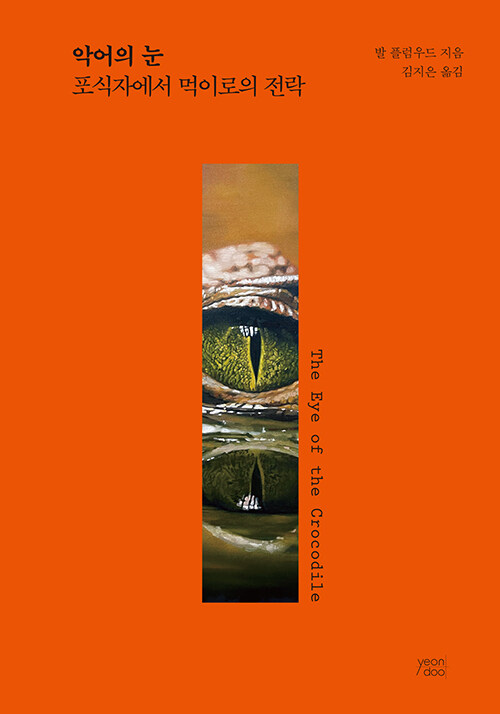




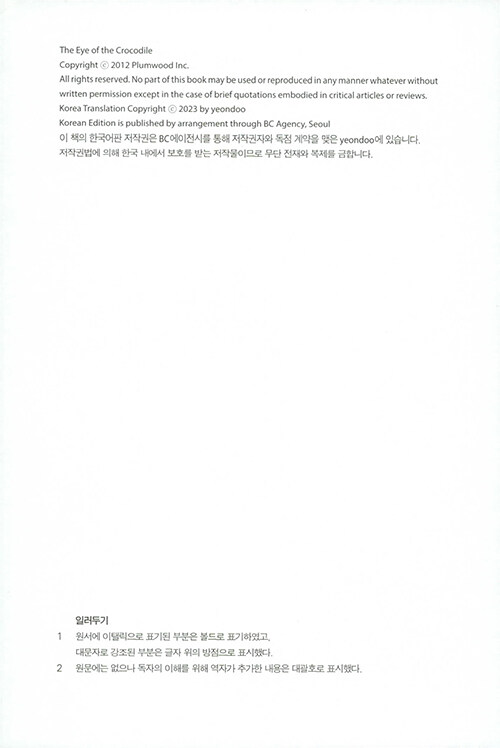

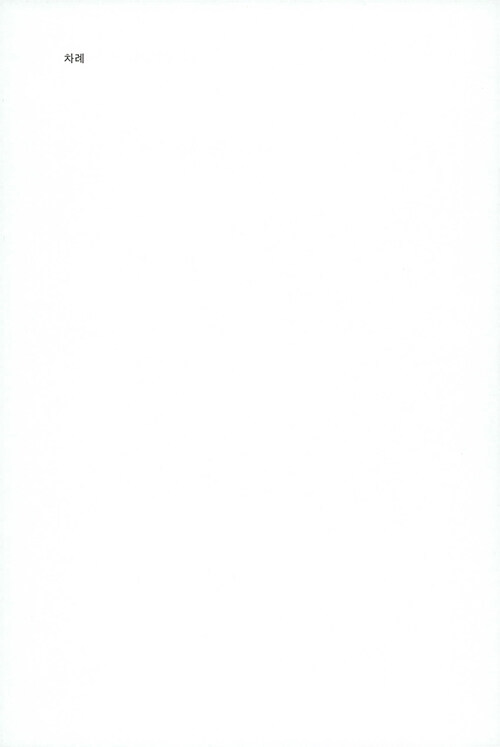

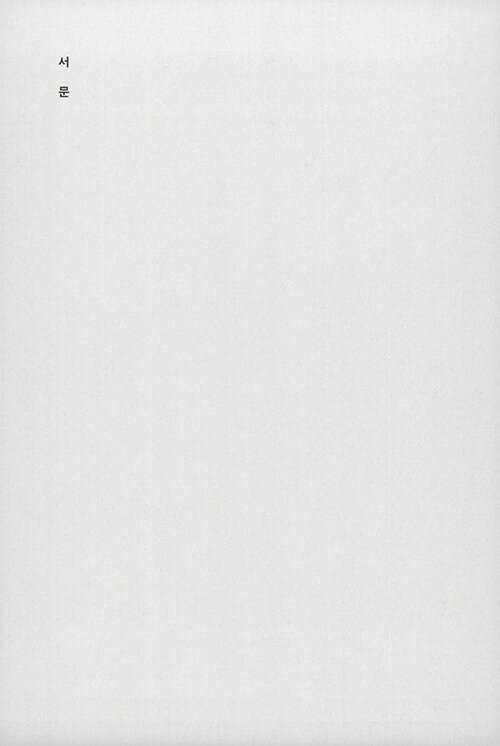

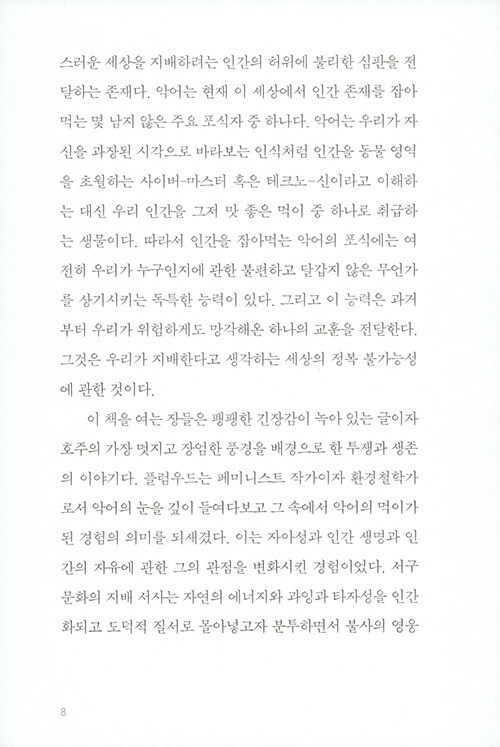
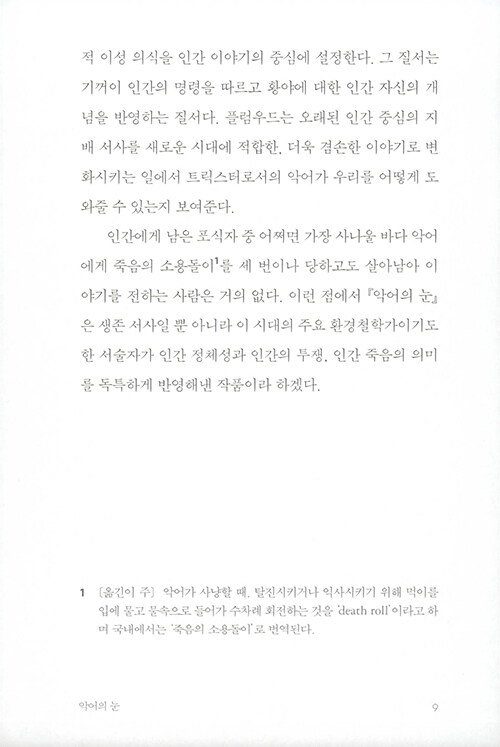

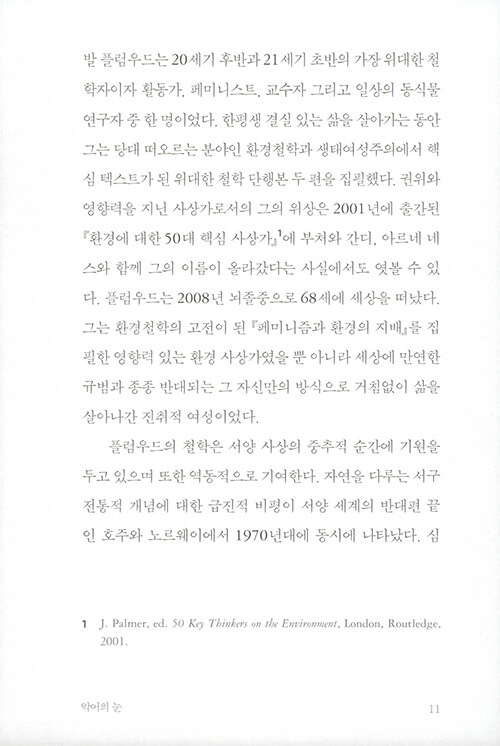
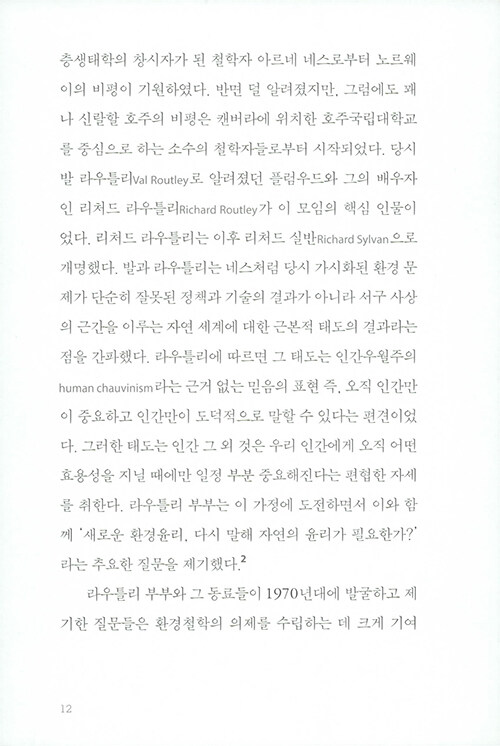

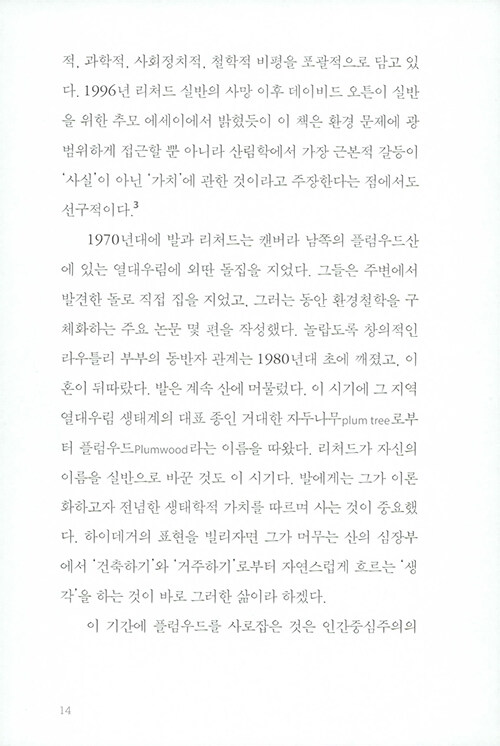
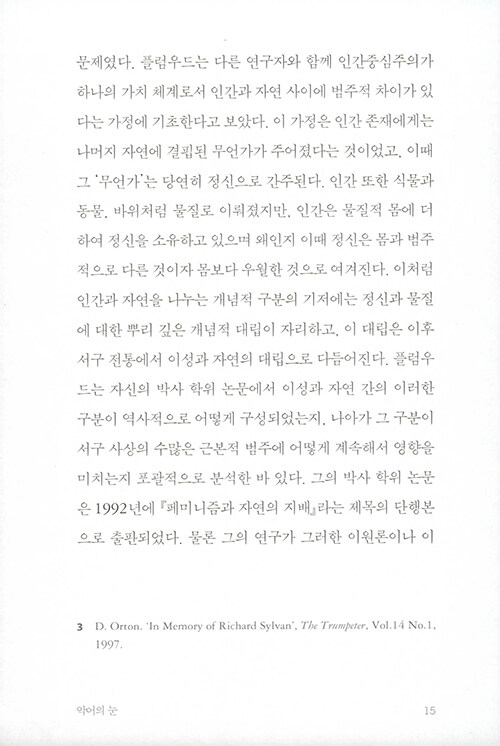

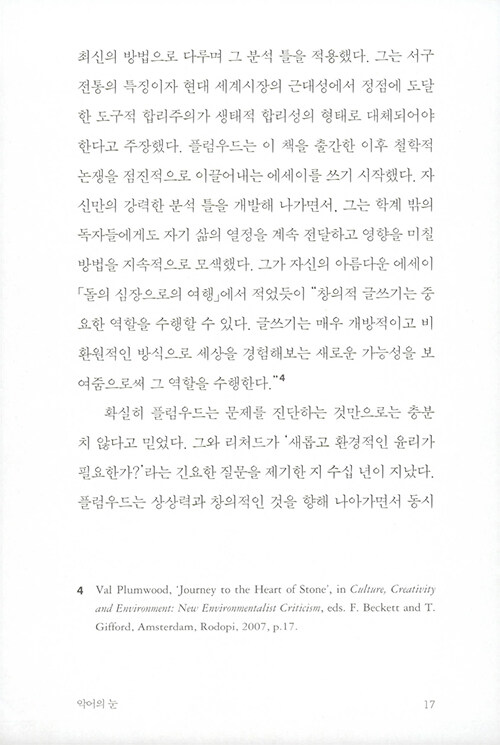
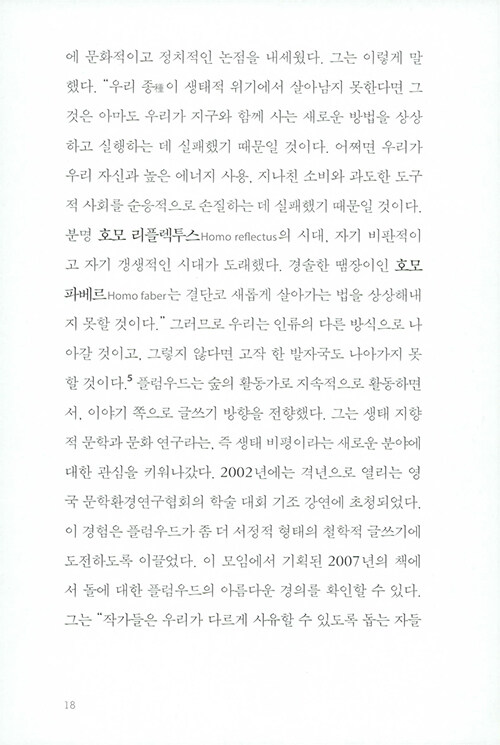
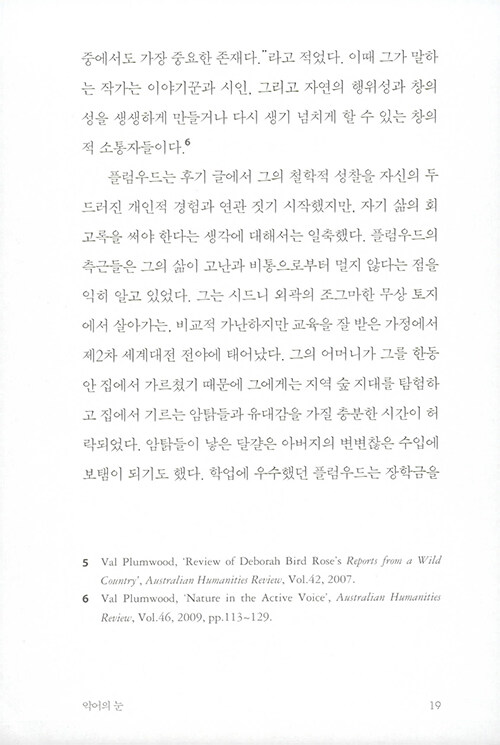



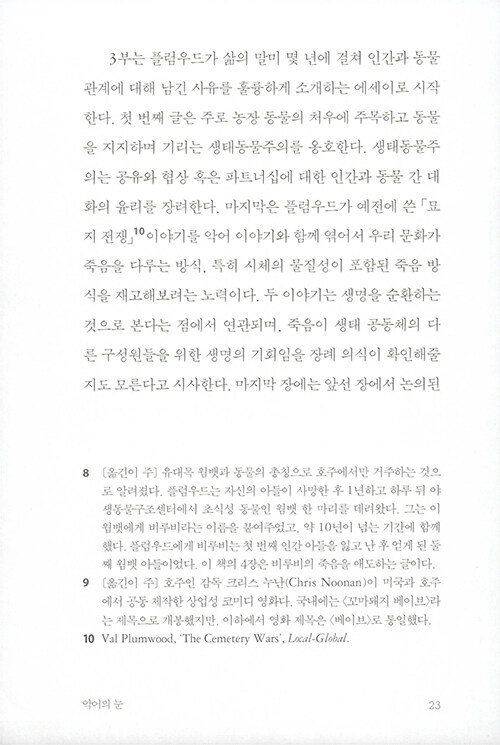
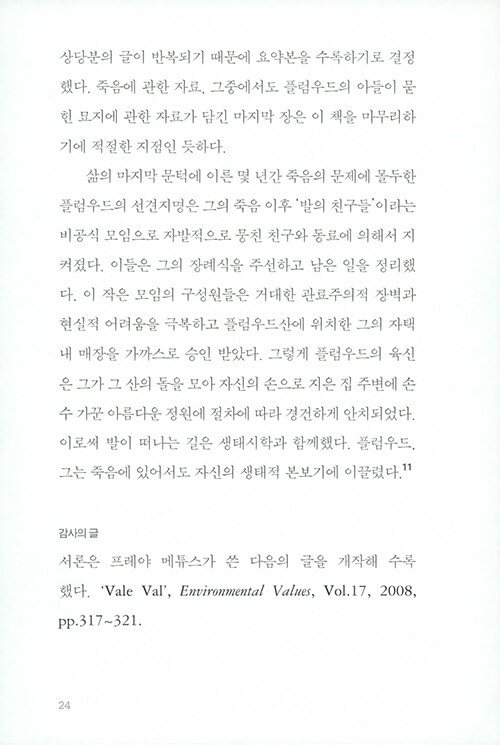

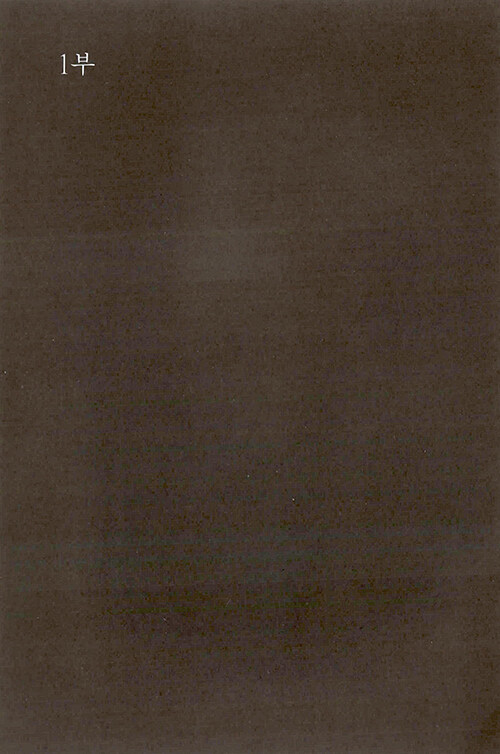

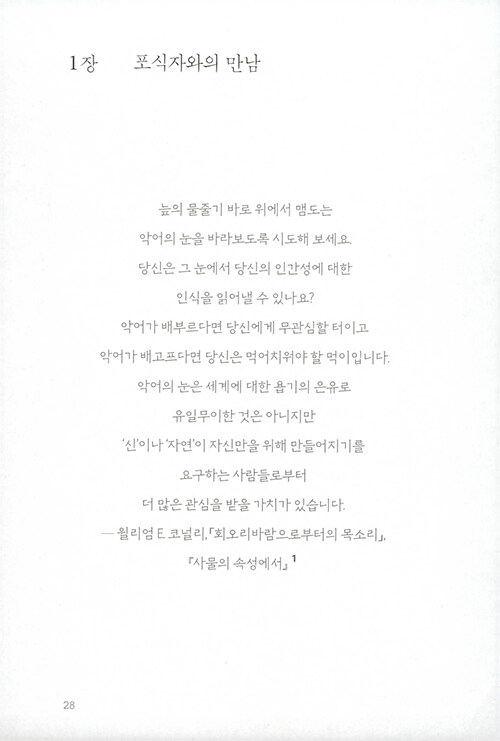

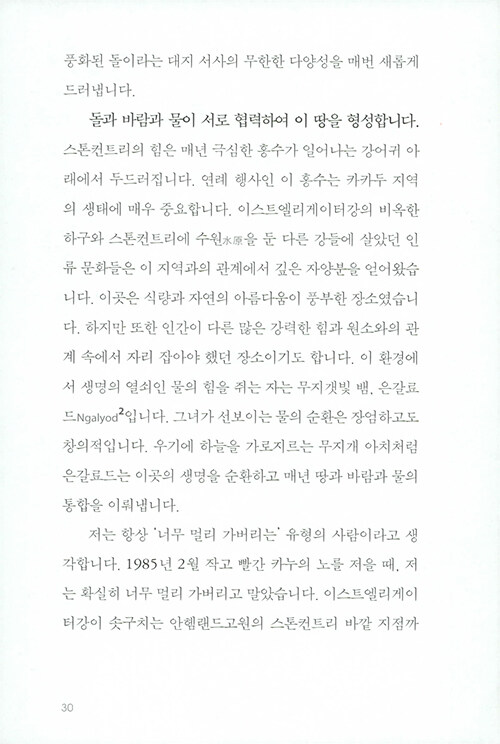

Sales Point : 1,570
 10.0 100자평(1)
10.0 100자평(1)
280쪽
140*200mm
412g
ISBN : 9791191840346
주제 분류
신간알리미 신청
국내도서 > 인문학 > 철학 일반 > 교양 철학
책소개
“하지만 인간은 먹이입니다.” 페미니스 생태철학자 발 플럼우드가 악어에게 잡어먹힐 뻔한 경험을 통해 직면한 인간과 자연의 가장 비밀스러운 진리.
우리는 언젠가 모두 죽는다. 나이 들어 자연사할 수도 있고, 병으로 예상보다 이른 시기에 사랑하는 사람들 곁을 떠날 수도 있다. 불운한 사고나 범죄도 배제할 수 없는 사인 중 하나다. 그 과정과 시기에 차이가 있을 뿐 언젠가 우리의 생명이 다한다는 것은 가장 확고한 진리다. 그런데 만일 우리가 다른 존재에게 잡아먹히는 것으로 생을 마감한다면 어떨까? 이런 생각은 감히 떠올리기조차 두렵고 잠시 스쳐 가는 것만으로 몸서리치는 분노를 불러일으킨다.
『악어의 눈』의 저자인 페미니스트 생태철학자 발 플럼우드는 그러나 인간은 먹이라고 힘주어 이야기한다. 1985년 호주의 카카두국립공원에서 카누를 타다 악어를 맞닥트려 ‘죽음의 소용돌이’를 세 번이나 당한 그는 강렬한 금빛 테두리가 빛나는 포식자의 눈을 마주한 순간 지금껏 안온하게 몸담아 온 세계에 일어난 균열을 느낀다. 인간은 최상위 포식자로서 모든 비인간 존재 위에 군림하며 그들을 마음껏 사용할 수 있지만, 그 역은 성립하지 않는다는 서구의 인간 중심적 세계관이 깨어지며 인간도 다른 모든 생명 존재와 마찬가지로 먹이사슬 안에 위치한다는 고통스러운 진실이 수면 위로 드러난 것이다.
플럼우드는 이 충격적인 경험을 담담히 공유하며, 스스로 주인이길 자처하는 인간의 오만함을 오늘날 우리가 처한 생태 위기의 원인으로 꼽는다. 또한 이 위기를 극복하기 위해서는 인간을 생태적 관점에서, 비인간 존재를 윤리적 관점에서 다시 위치시키는 두 과제가 동시에 수행되어야 한다고 주장한다. 인간과 비인간, 문명과 자연, 정신과 육체의 이분법을 넘어 모든 생명 존재가 몸인 만큼 정신이며, 마땅히 존중 받는 동시에 차례가 돌아오면 먹이로서 자신을 내어주어야 한다는 사실을 받아들여야 한다.
다소 무겁고 인정하기 벅찬 이 이야기를 플럼우드는 시종일관 다정한 목소리로 전달한다. 그는 악어에게 잡아먹힐 뻔한 압도적 경험을 비롯해 10년 넘게 집 안팎을 오가며 삶의 일부를 함께한 웜뱃 비루비와의 추억, 아들의 묘지를 방문하며 서구 매장 관행에 대해 돌아본 경험을 나누면서 이런 관점이 우리 삶과 동떨어진 것이 아니며, 오히려 가장 근본적으로 삶을 관통한다는 사실을 자연스럽게 받아들이게 한다. 『악어의 눈』은 우리가 눈감아버린 그러나 매우 중요한 이 진실에 용기 내어 다가가도록 우리를 독려하는 책이다. 다른 생명을 취해 자신의 생명을 유지하는 일에 대해 고민하는 이들에게 이 책이 믿음직한 안내자이자 동반자가 되어줄 것이다.
목차
서문
서론
1부 포식자에서 먹이로의 전락
1장 포식자와의 만남
2장 스톤컨트리의 건기
3장 균형 잡힌 바위의 지혜: 평행우주와 먹이의 관점
2부 비인간 생명 존재와의 소통
4장 웜뱃 경야: 비루비를 기억하며
5장 베이브, 말하는 고기의 이야기
3부 생명과 죽음의 생태적 순환
6장 동물과 생태: 더 나은 통합을 향해
7장 무미: 먹이로서 죽음에 접근하기
옮긴이의 말
참고문헌
감사의 글
접기
책속에서
P. 41 저는 악어의 눈을 통해 평행우주처럼 보이는 곳으로 뛰어들었습니다. 이곳은 ‘보통의 우주’와는 전혀 다른 규칙을 가진 우주입니다. 이 가혹하고 생소한 영토가 바로 모든 것이 흐르며, 우리가 다른 존재의 죽음을 살아가고, 다른 존재의 생명으로 죽는 헤라클레이토스적 우주입니다.
P. 52 하지만 인간은 먹이입니다. 인간은 상어와 사자와 호랑이와 곰과 악어의 먹이입니다. 인간은 까마귀와 뱀과 독수리와 돼지와 쥐와 큰도마뱀의 먹이이고, 수없이 많은 작은 생명체와 미생물의 먹이입니다.
P. 87 지난여름 북부 로키산맥의 회색 곰 지역을 걸으며 숱한 시간을 보낸 덕분에 제 존재를 알리는 쿠이 콜(cooee call)을 숙련하였습니다. 회색 곰 지역에서는 당혹스럽고 위험한 뜻밖의 일이 일어나지 않도록 회색 곰에게 자신의 존재를 계속해서 경고해야 합니다. (“친구야, 다시 한번 우스꽝스러운 쿠이 콜이야! 여기 입이 크고 맛없는 또 다른 호주인이 지나가.” 회색 곰이 하품하는 모습을 상상할 수 있겠지요.) 접기
P. 131 자신의 세계와 제 세계를 오가는 방법을 터득한 덕분에 비루비는 우리 사이의 균형을 능동적으로 결정하고 쌓아나갈 수 있었습니다. 그는 자신의 웜뱃다움을 온전히 유지하면서 제 세계로 들어올 수 있었습니다.
P. 185 돼지는 고기고, 돼지는 대상이며, 돼지는 그들의 주체성을 부정하고 멀리하고 숨기는 환원적 폭력에 시달린다는 점이 밝혀졌습니다. 베이브는 그가 살아 있을 때만 ‘돼지’라고 불리는 것입니다. 만족스러운 표정을 한 고양이가 자신의 특권적이고 보호 받는 지위를 뽐내면서, 베이브에게 “네가 죽은 후에 그들은 네게 ‘돼지고기나 베이컨’ 같은 다른 말을 사용해.”라고 설명합니다. 접기
더보기
추천글
이 책을 추천한 다른 분들 :
한겨레 신문
- 한겨레 신문 2023년 3월 10일자 '책&생각'
서울신문
- 서울신문 2023년 3월 10일자 '책꽂이'
동아일보
- 동아일보 2023년 3월 11일자 '책의 향기/뒷날개'
경향신문
- 경향신문 2023년 3월 10일자 '책과 삶'
세계일보
- 세계일보 2023년 3월 11일자
저자 및 역자소개
발 플럼우드 (Val Plumwood) (지은이)
저자파일
신간알리미 신청
호주의 페미니스트 생태학자이자 활동가로 한평생 인간과 자연의 공생적 관계를 이론화하고 실천하기 위해 노력했다. 호주와 미국 등 세계 명문 대학에서 강의했고 말년에는 호주국립대학에서 선임 연구원으로 활동했다. 1970년대부터 생태철학 분야에서 중추적 역할을 했으며, 1985년 호주 카카두국립공원에서 홀로 카약을 타던 중 악어에게 잡아먹힐 뻔했지만, 기적적으로 탈출한 경험으로 유명하다. 이후 자신이 온몸으로 생생히 체감한 자연의 먹이사슬, 자연과 인간의 관계에 천착하며 다수의 에세이를 집필했고, 그의 사후 동료들에 의해 『악어의 눈』으로 편집되고 출간되었다. 대표작으로는 1993년에 출간한 『페미니즘과 자연의 지배』와 2002년에 출간한『환경문화: 이성의 위기』 등이 있다. 생태철학에 대한 기여를 인정 받아 2001년 루틀리지 출판사가 선정한 50인의 환경 사상가 중 한 명으로 선정된 바 있다. 접기
최근작 : <악어의 눈>
김지은 (옮긴이)
저자파일
신간알리미 신청
경희대학교 글로벌커뮤니케이션학부 영미문화전공을 졸업하고 동 대학원에서 석사학위 취득 후 박사 과정을 수료했다. 루스 이리가레·마이클 마더의 『식물의 사유』를 공역했고, 공저로는 『도래할 유토피아들』, 『우리는 어떻게 사랑에 빠지는가』, 『위기의 시대, 인문학이 답하다』 등이 있다. 최근 신유물론 페미니즘과 생태에 관심을 두고 연구 중이다.
최근작 : <교차 2호 : 물질의 삶>,<위기의 시대, 인문학이 답하다>,<우리는 어떻게 사랑에 빠지는가> … 총 5종 (모두보기)
출판사 제공 책소개
페미니스트 생태철학자 발 플럼우드가 악어에게 잡아먹힐 뻔한 경험을 통해 직면한 인간과 자연의 가장 비밀스러운 진리!
왜 돼지는 먹어도 되고 개는 안 되는가? 개 식용을 반대하는 움직임이 있을 때마다 빠지지 않고 들려오는 항변이다. 그저 ‘보신탕’을 포기하고 싶지 않은 이들의 볼멘소리라고 치부하기에 앞서 왜 많은 사람이 돼지를 먹는 것보다 개를 먹는 것이 더 비윤리적인 일이라고 느끼는지 생각해보고자 한다면 『악어의 눈』이 그 사유의 토대를 마련해 줄 수 있을 것이다.
이 책의 저자 플럼우드는 악어에게 잡아먹힐 뻔한 경험을 공유하며 ‘먹이가 될 수 있는 존재’의 범위를 인간까지 확장하고, 영화 <베이브>에서 재현된 동물 농장의 경우를 예시로 들며 ‘존중 받아야 하는 존재’의 범위 안으로 돼지를 끌어들인다. 그리고 그 경계 밖에 어떤 생명 종도 남겨두지 않는다. 개별적 집합 두 개로 나뉘어 있던 존재들이 완전한 교집합 안으로 들어오는 것이다. “모든 살아 있는 생명체는 먹이고 동시에 먹이 그 이상”이다.
돼자나 개나 먹이사슬의 일부이니 개를 마음껏 잡아먹어도 된다는 이야기는 물론 아니다. 다만 문제가 되는 것은 포식 그 자체나 먹히고 사용되는 생명의 종류가 아니라 그 생명과 우리 자신을 완전히 다른 범주로 바라보고, 그들을 고깃덩어리로 환원하여 도구화하는 일이라는 것이 플럼우드의 관점이다. 개를 먹는 일이 돼지를 먹는 일보다 더 끔찍하게 느껴진다면 그것은 인간이 오래전 개를 길들이며 윤리적 고려의 범주 안으로 끌어들인 반면, 돼지는 고기의 범주에 남겨두었기 때문일 것이다. 그리고 개를 오직 고기로 바라보며 사육하고 도구화한다면 그것이 비판받아 마땅한 일이라는 사실은 달라지지 않는다.
플럼우드가 동물의 모든 쓰임을 예외 없이 완강히 거부해야 한다고 주장하는 존재론적 완전채식주의를 비판하는 것도 같은 맥락에서다. 세부적 상황을 고려하지 않은 동떨어진 방식의 채식주의는 존중 받는 생명의 범위를 인간 밖으로 확장할 뿐 윤리적 범주와 생태적 범주의 경계를 더욱 공고히 하며, 그 경계 밖에 존중의 대상이 되지 않는 존재를 여전히 남겨둔다. 농작이 여의치 않거나 오히려 포식보다 생태에 악영향을 미치는 환경에서 이루어지는 사냥과 포식조차 서구인의 시각에서 재단한다는 것, 동물을 극도로 도구화하고 ‘살’이나 ‘고기’로 환원하는 공장식 사육 농장과 비교적 동물을 존중하는 방식으로 운영되는 농장 사이의 차이를 지워버린다는 점 역시 저자가 지적하는 존재론적 완전채식주의의 한계다.
플럼우드에게 죽음은 우월한 영혼이 열등한 육체를 지상에 남겨두고 천국으로 향하는 일이 아니며, 그렇다고 모든 이야기가 끝나버리는 종착역도 아니다. 우리의 몸이 땅에 묻혀 수많은 벌레와 미생물의 먹이가 됨으로써, 그 토양에서 식물이 자라나고 그 식물이 동물의 먹이가 됨으로써 우리는 지구적 생태 공동체의 서사 안으로 걸어 들어간다. 우리는 우리 자신이 먹이라는 사실을 받아들이는 동시에 비인간 존재가 존중과 윤리적 고려의 대상임을, 우리와 그들의 세계가 나뉘어 있지 않음을 인정해야 한다. 그것이 플럼우드가 악어의 눈을 통해 발견하고, 이 책을 통해 우리에게 전달하는 진실이다. 접기
==





인간 동물을 먹이로 바라보는 악어의 눈을 보며 인간의 먹이됨과 비인간 동물의 관계성을 생각한 경험을 서술한다. 흥미로웠던 부분은 캐럴 아덤스와 같은 비건 페미니즘의 자민족 중심적이며 어느 정도는 환원론적인 측면을 비판하는 점이다. ‘고기‘ 옹호가 아닌 다른 입장을 제시한다.
序 2023-04-24 공감 (1) 댓글 (2)
Thanks to
공감
===
The Eye of the Crocodile
Val Plumwood , Lorraine Shannon
===

The Eye of the Crocodile
Val Plumwood
4.13
48 ratings4 reviews
Want to read
Buy on Amazon
Rate this book
Val Plumwood was an eminent environmental philosopher and activist who was prominent in the development of radical ecophilosophy from the early 1970s until her death in 2008. Her book Feminism and the Mastery of Nature (1992) has become a classic. In 1985 she was attacked by a crocodile while kayaking alone in the Kakadu national park in the Northern Territory. She was death rolled three times before being released from the crocodile’s jaws. She crawled for hours through swamp with appalling injuries before being rescued. The experience made her well placed to write about cultural responses to death and predation. The first section of The Eye of the Crocodile consists of chapters intended for a book on crocodiles that remained unfinished at the time of Val’s death. The remaining chapters are previously published papers brought together to form an overview of Val’s ideas on death, predation and nature.
GenresEcologyPhilosophyNonfictionAnimalsGenderEnvironment
99 pages, Paperback
First published January 1, 2012
Book details & editions



8 people are currently reading



185 people want to read
About the author

Val Plumwood11 books28 followers
Follow
Val Plumwood, formerly Val Routley, was an Australian ecofeminist intellectual and activist, who was prominent in the development of radical ecosophy from the early 1970s through the remainder of the 20th century.
Plumwood was active in movements to preserve biodiversity and halt deforestation from the 1960s on, and helped establish the trans-discipline known as ecological humanities.
At the time of her death, Plumwood was Australian Research Council Fellow at the Australian National University, and in the past had held positions at North Carolina State University, the University of Montana, and the University of Sydney.
In her 2000 essay "Being Prey", Val described her near-death experience that occurred during a solo canoe trip she took in 1985 in Australia's rugged bush territory. She was alone on the river and saw what appeared to be a "floating stick" that she soon realized was a crocodile. Before she could get ashore the crocodile attacked her canoe and in her attempt to leap ashore to avoid being capsized, Val was seized by the crocodile. The essay describes the "death rolls" the croc put her through several times, though miraculously she escaped to crawl nearly two miles to a rescue point. From this experience, Val gained a perspective that humans are part of the food chain as well, and that our culture's human-centric view is disconnected from the reality that we also are food for animals.
(http://en.wikipedia.org/wiki/Val_Plum...)

Richard Reese
3 books · 161 followers
Follow
June 9, 2015
In February 1985, Val Plumwood was having a lovely time canoeing by herself in Australia’s Kakadu National Park. The ranger had assured her that the saltwater crocodiles, notorious man-eaters, never attacked canoes. It was a perfect day, gliding across the water in a beautiful land, no worries.
She was a scholar and writer who focused on feminism and environmental philosophy. The Earth Crisis was pounding the planet, and it was obvious to eco-thinkers that this was caused by a severely dysfunctional philosophy. Her book, The Eye of the Crocodile, is a fascinating voyage into the realm of ethics, values, and beliefs.
Plumwood understood that the ancient culture of the Aborigines was the opposite of insane, and she had tremendous respect for it. It presented a time-proven example of an ethic that had enabled a healthy and stable way of life for more than 12,000 years. Australia was blessed with a bipolar climate that often swung between drought and deluge, making low-tech agriculture impractical. The land escaped the curse of cities until you-know-who washed up on shore. (As her canoe gently drifted, a floating stick slowly moved closer.)
Plumwood grew up in a rural area. She was home schooled, and enjoyed a fairy tale childhood outdoors, delighted by the “sensuous richness” of the forest. She was unlike most of her generation, because “I acquired an unquenchable thirst for life, for the wisdom of the land.” Thus, her appreciation of the Aboriginal culture was not merely intellectual — it was real and deep. Unlike most of her generation, she enjoyed a spiritual connection to the land. (The floating stick had two beautiful eyes.)
The stick with two eyes was a crocodile, nearly as big as the canoe, and it was five minutes to lunchtime. Suddenly, the reptile began ramming her canoe. She rushed toward shore, but the crocodile leaped and grabbed her between the legs. Three times it pulled her underwater, trying to drown her. Miraculously, she managed to escape, severely injured, and survived.
It was a mind-blowing life changing experience. Intellectually, she had understood food chains, predators, and prey. But this was the first time in her life that she was nothing more than a big juicy meatball — impossible! She was far more than food! The crocodile strongly disagreed. Its sharp teeth drove home the message that she was not outside of nature. She was a part of the ecosystem, an animal, and nourishing meat — no more significant than a moth or mouse.
She wrote, “In the vivid intensity of those last moments, when great, toothed jaws descend upon you, it can hit you like a thunderclap that you were completely wrong about it all — not only about what your own personal life meant, but about what life and death themselves actually mean.”
She was blindsided by the realization that an entire highly educated civilization could be wrong about subjects so basic — animality, food, and the dance of life and death. The crocodile painfully drove home the point that the entire modern culture was living in a fantasy. Our highly contagious culture was ravaging the planet, and we didn’t understand why. Each new generation was trained to live and think like imperial space aliens.
Plumwood was educated by the space alien culture, but the crocodile was a powerful teacher from the real world, the ecosystem. Darwin revealed that humans are animals, but this essential truth harmlessly bounced off a long tradition of human supremacist illusions. It was easy to see that those who were demolishing the planet were radicalized space aliens who believed that human society was completely outside of nature, and far above it.
The Aboriginal people inhabited the real world. They were wild two-legged animals who had learned the wisdom of voluntary self-restraint. For them, the entire land was alive, intelligent, and sacred; even the plants, streams, and rocks — everything. Nobody owned it. Mindfully inhabiting a sacred place required a profound sense of respect.
Space aliens drove them crazy. Colonists in spandex jogged mindlessly across sacred land, listening to electronic pop music. Reverence was absent. They did not belong to the land, and were unaware of its incredible power. Some of the traditional folks wanted to ban these disrespectful intrusions. The colonial era had been a disaster.
The colonial worldview had many layers of hierarchy. At the summit were the elites. Below them were women, peasants, slaves, and the colonized. Beneath the humans were animals. Some critters, like dogs, cats, and horses, had special status. If they obediently submitted to human domination, they were not meat. Below them were meat class animals that had no consciousness. Especially despised were man-eating animals, and critters that molested human property. They were mercilessly exterminated. Beneath animals was the plant world, a far older realm.
The foundation of the dominant worldview was human supremacy, and this mode of thinking had been the driving force behind a growing tsunami of ecological devastation. Plumwood saw two alternatives to supremacist thinking.
(1) Ecological animalism was the realm of crocodiles, Aborigines, our wild ancestors, and the rest of the natural world. All life was food, including humans. In an ecosystem, “we live the other’s death, die the other’s life.” Our bodies belonged to the ecosystem, not to ourselves. The spirits of animate and inanimate beings had equal significance.
(2) Ontological veganism did not believe in using animals or eating animal foods. This ethic was an offshoot of human supremacy. It did not condemn the dogma of human/nature dualism. It denied that humans were meat, despite the fact that a number of large predators have been dining on us for countless centuries. It believed that animals were worthy of moral consideration, but the plant people were not.
Ontological veganism was queasy about predation; it would prefer a predator-free world. It believed that human hunting was cultural (animal abuse), while animal predation was natural (instinctive). But every newborn human has a body carefully designed by evolution for a life of hunting. We are capable of smoothly running for hours on two legs, and we have hands, arms, and shoulders that are fine-tuned for accurately throwing projectiles in a forceful manner. What you see in the mirror is a hunter.
Plumwood was a vegetarian because she believed that the production of meat on factory farms was ethically wrong. She had no problems with Aborigines hunting for dinner. All of the world’s sustainable wild cultures consumed animal foods. She was well aware that her plant food diet was not ecologically harmless.
Cultures rooted in human supremacy have achieved remarkable success at rubbishing entire ecosystems. This is not about flawed genes. It’s about a bunch of screwy ideas that we’ve been taught. Sustainable cultures perceive reality in a radically different way. Luckily, software is editable. Plumwood recommended that creative communicators bring new ideas to our dying culture; stories that help us find our way home to the family of life. This is an enormous challenge.
Plumwood also wrote an essay, Prey to a Crocodile, which is not in the book. It provides a detailed discussion of the attack. The rangers wanted to go back the next day, and kill the crocodile. She strongly objected. The crocodile had done nothing wrong. Predation is normal and healthy. She had been an intruder.
A free PDF of the entire contents of The Eye of the Crocodile is available online. It’s just 111 pages. A paperback edition is still in print.
2 likes
Like
Comment

Konnie Willett
3 reviews · 1 follower
Follow
January 8, 2022
I discovered this book on the Knowing Animals podcast. I was so drawn to it because Val Plumwood, an established academic at the time, was kayaking in a lake, when she was attacked by a crocodile and death rolled three times. This experience made Plumwood well-equipped to discuss predation, food and death in her later works.
One of the more controversial points she makes in the book, is that humans are food (for predators) though we try to deny it. We eat other animals, but we cannot be eaten. We justify this because we have minds and are rational, and non-human animals are not. But they do have minds, intentions, feelings and culture, just like us.
This refusal to believe that we are food, can be evidenced in our burial processes. We are buried in a coffin so that we cannot go back into the earth and be eaten by others. We do not allow our decaying bodies to nourish the land and worms that gave us life in the first place.
In the second section of her book she describes, Birubi, an orphaned wombat she adopted, who grew to live both inside and outside her home, in the wild, at his choosing, for twelve years before his death. He knew how to open the sliding doors into her kitchen, he loved to play and fall asleep in front of the fire, and he would demand to sleep next to her. This reminded me of my relationship with my companion animal, Lola, and that, although we don’t share the same language, we communicate. That humans and non-human animals can create intricate and meaning relationships with one another. She then discusses the movie, ‘Babe’ and how Babe the pig, shows that non-human animals are communicative beings. To call them “meat” is to deny them this status and enables us to eat them. Instead indigenous cultures don’t deny animals abilities, cognition or feelings, in order to eat them. They recognise the conflict.
Though I don’t agree with her postulation that we can respectfully use animals for food, I do take home the above points. It’s an eye-opening book, written by an author well placed to discuss the idea of being food, death and predation!
2 likes
Like
Comment

Sarai
8 reviews · 11 followers
Follow
April 18, 2016
Awesome book. Really enjoyed reading a feminist's view on topics such as vegetarianism and veganism. She went through a near-death experience with a crocodile, and thankfully she shared her reflections with us, on how we have distanced ourselves from this "other" world which is the real world, a world in which not only animals are food, but we humans are food too. I guess facing a crocodile and surviving three attacks gives her all the credentials she needs to talk about these things!
1 like
Like
Comment
Steve Paulson
50 reviews · 1 follower
Follow
September 17, 2020
If you are food, what kind of world do you want to live in?
environment gender philosophy
Like
Comment
===



































Sales Point : 1,570

280쪽
140*200mm
412g
ISBN : 9791191840346
주제 분류
신간알리미 신청
국내도서 > 인문학 > 철학 일반 > 교양 철학
책소개
“하지만 인간은 먹이입니다.” 페미니스 생태철학자 발 플럼우드가 악어에게 잡어먹힐 뻔한 경험을 통해 직면한 인간과 자연의 가장 비밀스러운 진리.
우리는 언젠가 모두 죽는다. 나이 들어 자연사할 수도 있고, 병으로 예상보다 이른 시기에 사랑하는 사람들 곁을 떠날 수도 있다. 불운한 사고나 범죄도 배제할 수 없는 사인 중 하나다. 그 과정과 시기에 차이가 있을 뿐 언젠가 우리의 생명이 다한다는 것은 가장 확고한 진리다. 그런데 만일 우리가 다른 존재에게 잡아먹히는 것으로 생을 마감한다면 어떨까? 이런 생각은 감히 떠올리기조차 두렵고 잠시 스쳐 가는 것만으로 몸서리치는 분노를 불러일으킨다.
『악어의 눈』의 저자인 페미니스트 생태철학자 발 플럼우드는 그러나 인간은 먹이라고 힘주어 이야기한다. 1985년 호주의 카카두국립공원에서 카누를 타다 악어를 맞닥트려 ‘죽음의 소용돌이’를 세 번이나 당한 그는 강렬한 금빛 테두리가 빛나는 포식자의 눈을 마주한 순간 지금껏 안온하게 몸담아 온 세계에 일어난 균열을 느낀다. 인간은 최상위 포식자로서 모든 비인간 존재 위에 군림하며 그들을 마음껏 사용할 수 있지만, 그 역은 성립하지 않는다는 서구의 인간 중심적 세계관이 깨어지며 인간도 다른 모든 생명 존재와 마찬가지로 먹이사슬 안에 위치한다는 고통스러운 진실이 수면 위로 드러난 것이다.
플럼우드는 이 충격적인 경험을 담담히 공유하며, 스스로 주인이길 자처하는 인간의 오만함을 오늘날 우리가 처한 생태 위기의 원인으로 꼽는다. 또한 이 위기를 극복하기 위해서는 인간을 생태적 관점에서, 비인간 존재를 윤리적 관점에서 다시 위치시키는 두 과제가 동시에 수행되어야 한다고 주장한다. 인간과 비인간, 문명과 자연, 정신과 육체의 이분법을 넘어 모든 생명 존재가 몸인 만큼 정신이며, 마땅히 존중 받는 동시에 차례가 돌아오면 먹이로서 자신을 내어주어야 한다는 사실을 받아들여야 한다.
다소 무겁고 인정하기 벅찬 이 이야기를 플럼우드는 시종일관 다정한 목소리로 전달한다. 그는 악어에게 잡아먹힐 뻔한 압도적 경험을 비롯해 10년 넘게 집 안팎을 오가며 삶의 일부를 함께한 웜뱃 비루비와의 추억, 아들의 묘지를 방문하며 서구 매장 관행에 대해 돌아본 경험을 나누면서 이런 관점이 우리 삶과 동떨어진 것이 아니며, 오히려 가장 근본적으로 삶을 관통한다는 사실을 자연스럽게 받아들이게 한다. 『악어의 눈』은 우리가 눈감아버린 그러나 매우 중요한 이 진실에 용기 내어 다가가도록 우리를 독려하는 책이다. 다른 생명을 취해 자신의 생명을 유지하는 일에 대해 고민하는 이들에게 이 책이 믿음직한 안내자이자 동반자가 되어줄 것이다.
목차
서문
서론
1부 포식자에서 먹이로의 전락
1장 포식자와의 만남
2장 스톤컨트리의 건기
3장 균형 잡힌 바위의 지혜: 평행우주와 먹이의 관점
2부 비인간 생명 존재와의 소통
4장 웜뱃 경야: 비루비를 기억하며
5장 베이브, 말하는 고기의 이야기
3부 생명과 죽음의 생태적 순환
6장 동물과 생태: 더 나은 통합을 향해
7장 무미: 먹이로서 죽음에 접근하기
옮긴이의 말
참고문헌
감사의 글
접기
책속에서
P. 41 저는 악어의 눈을 통해 평행우주처럼 보이는 곳으로 뛰어들었습니다. 이곳은 ‘보통의 우주’와는 전혀 다른 규칙을 가진 우주입니다. 이 가혹하고 생소한 영토가 바로 모든 것이 흐르며, 우리가 다른 존재의 죽음을 살아가고, 다른 존재의 생명으로 죽는 헤라클레이토스적 우주입니다.
P. 52 하지만 인간은 먹이입니다. 인간은 상어와 사자와 호랑이와 곰과 악어의 먹이입니다. 인간은 까마귀와 뱀과 독수리와 돼지와 쥐와 큰도마뱀의 먹이이고, 수없이 많은 작은 생명체와 미생물의 먹이입니다.
P. 87 지난여름 북부 로키산맥의 회색 곰 지역을 걸으며 숱한 시간을 보낸 덕분에 제 존재를 알리는 쿠이 콜(cooee call)을 숙련하였습니다. 회색 곰 지역에서는 당혹스럽고 위험한 뜻밖의 일이 일어나지 않도록 회색 곰에게 자신의 존재를 계속해서 경고해야 합니다. (“친구야, 다시 한번 우스꽝스러운 쿠이 콜이야! 여기 입이 크고 맛없는 또 다른 호주인이 지나가.” 회색 곰이 하품하는 모습을 상상할 수 있겠지요.) 접기
P. 131 자신의 세계와 제 세계를 오가는 방법을 터득한 덕분에 비루비는 우리 사이의 균형을 능동적으로 결정하고 쌓아나갈 수 있었습니다. 그는 자신의 웜뱃다움을 온전히 유지하면서 제 세계로 들어올 수 있었습니다.
P. 185 돼지는 고기고, 돼지는 대상이며, 돼지는 그들의 주체성을 부정하고 멀리하고 숨기는 환원적 폭력에 시달린다는 점이 밝혀졌습니다. 베이브는 그가 살아 있을 때만 ‘돼지’라고 불리는 것입니다. 만족스러운 표정을 한 고양이가 자신의 특권적이고 보호 받는 지위를 뽐내면서, 베이브에게 “네가 죽은 후에 그들은 네게 ‘돼지고기나 베이컨’ 같은 다른 말을 사용해.”라고 설명합니다. 접기
더보기
추천글
이 책을 추천한 다른 분들 :
한겨레 신문
- 한겨레 신문 2023년 3월 10일자 '책&생각'
서울신문
- 서울신문 2023년 3월 10일자 '책꽂이'
동아일보
- 동아일보 2023년 3월 11일자 '책의 향기/뒷날개'
경향신문
- 경향신문 2023년 3월 10일자 '책과 삶'
세계일보
- 세계일보 2023년 3월 11일자
저자 및 역자소개
발 플럼우드 (Val Plumwood) (지은이)
저자파일
신간알리미 신청
호주의 페미니스트 생태학자이자 활동가로 한평생 인간과 자연의 공생적 관계를 이론화하고 실천하기 위해 노력했다. 호주와 미국 등 세계 명문 대학에서 강의했고 말년에는 호주국립대학에서 선임 연구원으로 활동했다. 1970년대부터 생태철학 분야에서 중추적 역할을 했으며, 1985년 호주 카카두국립공원에서 홀로 카약을 타던 중 악어에게 잡아먹힐 뻔했지만, 기적적으로 탈출한 경험으로 유명하다. 이후 자신이 온몸으로 생생히 체감한 자연의 먹이사슬, 자연과 인간의 관계에 천착하며 다수의 에세이를 집필했고, 그의 사후 동료들에 의해 『악어의 눈』으로 편집되고 출간되었다. 대표작으로는 1993년에 출간한 『페미니즘과 자연의 지배』와 2002년에 출간한『환경문화: 이성의 위기』 등이 있다. 생태철학에 대한 기여를 인정 받아 2001년 루틀리지 출판사가 선정한 50인의 환경 사상가 중 한 명으로 선정된 바 있다. 접기
최근작 : <악어의 눈>
김지은 (옮긴이)
저자파일
신간알리미 신청
경희대학교 글로벌커뮤니케이션학부 영미문화전공을 졸업하고 동 대학원에서 석사학위 취득 후 박사 과정을 수료했다. 루스 이리가레·마이클 마더의 『식물의 사유』를 공역했고, 공저로는 『도래할 유토피아들』, 『우리는 어떻게 사랑에 빠지는가』, 『위기의 시대, 인문학이 답하다』 등이 있다. 최근 신유물론 페미니즘과 생태에 관심을 두고 연구 중이다.
최근작 : <교차 2호 : 물질의 삶>,<위기의 시대, 인문학이 답하다>,<우리는 어떻게 사랑에 빠지는가> … 총 5종 (모두보기)
출판사 제공 책소개
페미니스트 생태철학자 발 플럼우드가 악어에게 잡아먹힐 뻔한 경험을 통해 직면한 인간과 자연의 가장 비밀스러운 진리!
왜 돼지는 먹어도 되고 개는 안 되는가? 개 식용을 반대하는 움직임이 있을 때마다 빠지지 않고 들려오는 항변이다. 그저 ‘보신탕’을 포기하고 싶지 않은 이들의 볼멘소리라고 치부하기에 앞서 왜 많은 사람이 돼지를 먹는 것보다 개를 먹는 것이 더 비윤리적인 일이라고 느끼는지 생각해보고자 한다면 『악어의 눈』이 그 사유의 토대를 마련해 줄 수 있을 것이다.
이 책의 저자 플럼우드는 악어에게 잡아먹힐 뻔한 경험을 공유하며 ‘먹이가 될 수 있는 존재’의 범위를 인간까지 확장하고, 영화 <베이브>에서 재현된 동물 농장의 경우를 예시로 들며 ‘존중 받아야 하는 존재’의 범위 안으로 돼지를 끌어들인다. 그리고 그 경계 밖에 어떤 생명 종도 남겨두지 않는다. 개별적 집합 두 개로 나뉘어 있던 존재들이 완전한 교집합 안으로 들어오는 것이다. “모든 살아 있는 생명체는 먹이고 동시에 먹이 그 이상”이다.
돼자나 개나 먹이사슬의 일부이니 개를 마음껏 잡아먹어도 된다는 이야기는 물론 아니다. 다만 문제가 되는 것은 포식 그 자체나 먹히고 사용되는 생명의 종류가 아니라 그 생명과 우리 자신을 완전히 다른 범주로 바라보고, 그들을 고깃덩어리로 환원하여 도구화하는 일이라는 것이 플럼우드의 관점이다. 개를 먹는 일이 돼지를 먹는 일보다 더 끔찍하게 느껴진다면 그것은 인간이 오래전 개를 길들이며 윤리적 고려의 범주 안으로 끌어들인 반면, 돼지는 고기의 범주에 남겨두었기 때문일 것이다. 그리고 개를 오직 고기로 바라보며 사육하고 도구화한다면 그것이 비판받아 마땅한 일이라는 사실은 달라지지 않는다.
플럼우드가 동물의 모든 쓰임을 예외 없이 완강히 거부해야 한다고 주장하는 존재론적 완전채식주의를 비판하는 것도 같은 맥락에서다. 세부적 상황을 고려하지 않은 동떨어진 방식의 채식주의는 존중 받는 생명의 범위를 인간 밖으로 확장할 뿐 윤리적 범주와 생태적 범주의 경계를 더욱 공고히 하며, 그 경계 밖에 존중의 대상이 되지 않는 존재를 여전히 남겨둔다. 농작이 여의치 않거나 오히려 포식보다 생태에 악영향을 미치는 환경에서 이루어지는 사냥과 포식조차 서구인의 시각에서 재단한다는 것, 동물을 극도로 도구화하고 ‘살’이나 ‘고기’로 환원하는 공장식 사육 농장과 비교적 동물을 존중하는 방식으로 운영되는 농장 사이의 차이를 지워버린다는 점 역시 저자가 지적하는 존재론적 완전채식주의의 한계다.
플럼우드에게 죽음은 우월한 영혼이 열등한 육체를 지상에 남겨두고 천국으로 향하는 일이 아니며, 그렇다고 모든 이야기가 끝나버리는 종착역도 아니다. 우리의 몸이 땅에 묻혀 수많은 벌레와 미생물의 먹이가 됨으로써, 그 토양에서 식물이 자라나고 그 식물이 동물의 먹이가 됨으로써 우리는 지구적 생태 공동체의 서사 안으로 걸어 들어간다. 우리는 우리 자신이 먹이라는 사실을 받아들이는 동시에 비인간 존재가 존중과 윤리적 고려의 대상임을, 우리와 그들의 세계가 나뉘어 있지 않음을 인정해야 한다. 그것이 플럼우드가 악어의 눈을 통해 발견하고, 이 책을 통해 우리에게 전달하는 진실이다. 접기
==
인간 동물을 먹이로 바라보는 악어의 눈을 보며 인간의 먹이됨과 비인간 동물의 관계성을 생각한 경험을 서술한다. 흥미로웠던 부분은 캐럴 아덤스와 같은 비건 페미니즘의 자민족 중심적이며 어느 정도는 환원론적인 측면을 비판하는 점이다. ‘고기‘ 옹호가 아닌 다른 입장을 제시한다.
序 2023-04-24 공감 (1) 댓글 (2)
Thanks to
공감
===
The Eye of the Crocodile
Val Plumwood , Lorraine Shannon
===

The Eye of the Crocodile
Val Plumwood
4.13
48 ratings4 reviews
Want to read
Buy on Amazon
Rate this book
Val Plumwood was an eminent environmental philosopher and activist who was prominent in the development of radical ecophilosophy from the early 1970s until her death in 2008. Her book Feminism and the Mastery of Nature (1992) has become a classic. In 1985 she was attacked by a crocodile while kayaking alone in the Kakadu national park in the Northern Territory. She was death rolled three times before being released from the crocodile’s jaws. She crawled for hours through swamp with appalling injuries before being rescued. The experience made her well placed to write about cultural responses to death and predation. The first section of The Eye of the Crocodile consists of chapters intended for a book on crocodiles that remained unfinished at the time of Val’s death. The remaining chapters are previously published papers brought together to form an overview of Val’s ideas on death, predation and nature.
GenresEcologyPhilosophyNonfictionAnimalsGenderEnvironment
99 pages, Paperback
First published January 1, 2012
Book details & editions



8 people are currently reading



185 people want to read
About the author

Val Plumwood11 books28 followers
Follow
Val Plumwood, formerly Val Routley, was an Australian ecofeminist intellectual and activist, who was prominent in the development of radical ecosophy from the early 1970s through the remainder of the 20th century.
Plumwood was active in movements to preserve biodiversity and halt deforestation from the 1960s on, and helped establish the trans-discipline known as ecological humanities.
At the time of her death, Plumwood was Australian Research Council Fellow at the Australian National University, and in the past had held positions at North Carolina State University, the University of Montana, and the University of Sydney.
In her 2000 essay "Being Prey", Val described her near-death experience that occurred during a solo canoe trip she took in 1985 in Australia's rugged bush territory. She was alone on the river and saw what appeared to be a "floating stick" that she soon realized was a crocodile. Before she could get ashore the crocodile attacked her canoe and in her attempt to leap ashore to avoid being capsized, Val was seized by the crocodile. The essay describes the "death rolls" the croc put her through several times, though miraculously she escaped to crawl nearly two miles to a rescue point. From this experience, Val gained a perspective that humans are part of the food chain as well, and that our culture's human-centric view is disconnected from the reality that we also are food for animals.
(http://en.wikipedia.org/wiki/Val_Plum...)

Richard Reese
3 books · 161 followers
Follow
June 9, 2015
In February 1985, Val Plumwood was having a lovely time canoeing by herself in Australia’s Kakadu National Park. The ranger had assured her that the saltwater crocodiles, notorious man-eaters, never attacked canoes. It was a perfect day, gliding across the water in a beautiful land, no worries.
She was a scholar and writer who focused on feminism and environmental philosophy. The Earth Crisis was pounding the planet, and it was obvious to eco-thinkers that this was caused by a severely dysfunctional philosophy. Her book, The Eye of the Crocodile, is a fascinating voyage into the realm of ethics, values, and beliefs.
Plumwood understood that the ancient culture of the Aborigines was the opposite of insane, and she had tremendous respect for it. It presented a time-proven example of an ethic that had enabled a healthy and stable way of life for more than 12,000 years. Australia was blessed with a bipolar climate that often swung between drought and deluge, making low-tech agriculture impractical. The land escaped the curse of cities until you-know-who washed up on shore. (As her canoe gently drifted, a floating stick slowly moved closer.)
Plumwood grew up in a rural area. She was home schooled, and enjoyed a fairy tale childhood outdoors, delighted by the “sensuous richness” of the forest. She was unlike most of her generation, because “I acquired an unquenchable thirst for life, for the wisdom of the land.” Thus, her appreciation of the Aboriginal culture was not merely intellectual — it was real and deep. Unlike most of her generation, she enjoyed a spiritual connection to the land. (The floating stick had two beautiful eyes.)
The stick with two eyes was a crocodile, nearly as big as the canoe, and it was five minutes to lunchtime. Suddenly, the reptile began ramming her canoe. She rushed toward shore, but the crocodile leaped and grabbed her between the legs. Three times it pulled her underwater, trying to drown her. Miraculously, she managed to escape, severely injured, and survived.
It was a mind-blowing life changing experience. Intellectually, she had understood food chains, predators, and prey. But this was the first time in her life that she was nothing more than a big juicy meatball — impossible! She was far more than food! The crocodile strongly disagreed. Its sharp teeth drove home the message that she was not outside of nature. She was a part of the ecosystem, an animal, and nourishing meat — no more significant than a moth or mouse.
She wrote, “In the vivid intensity of those last moments, when great, toothed jaws descend upon you, it can hit you like a thunderclap that you were completely wrong about it all — not only about what your own personal life meant, but about what life and death themselves actually mean.”
She was blindsided by the realization that an entire highly educated civilization could be wrong about subjects so basic — animality, food, and the dance of life and death. The crocodile painfully drove home the point that the entire modern culture was living in a fantasy. Our highly contagious culture was ravaging the planet, and we didn’t understand why. Each new generation was trained to live and think like imperial space aliens.
Plumwood was educated by the space alien culture, but the crocodile was a powerful teacher from the real world, the ecosystem. Darwin revealed that humans are animals, but this essential truth harmlessly bounced off a long tradition of human supremacist illusions. It was easy to see that those who were demolishing the planet were radicalized space aliens who believed that human society was completely outside of nature, and far above it.
The Aboriginal people inhabited the real world. They were wild two-legged animals who had learned the wisdom of voluntary self-restraint. For them, the entire land was alive, intelligent, and sacred; even the plants, streams, and rocks — everything. Nobody owned it. Mindfully inhabiting a sacred place required a profound sense of respect.
Space aliens drove them crazy. Colonists in spandex jogged mindlessly across sacred land, listening to electronic pop music. Reverence was absent. They did not belong to the land, and were unaware of its incredible power. Some of the traditional folks wanted to ban these disrespectful intrusions. The colonial era had been a disaster.
The colonial worldview had many layers of hierarchy. At the summit were the elites. Below them were women, peasants, slaves, and the colonized. Beneath the humans were animals. Some critters, like dogs, cats, and horses, had special status. If they obediently submitted to human domination, they were not meat. Below them were meat class animals that had no consciousness. Especially despised were man-eating animals, and critters that molested human property. They were mercilessly exterminated. Beneath animals was the plant world, a far older realm.
The foundation of the dominant worldview was human supremacy, and this mode of thinking had been the driving force behind a growing tsunami of ecological devastation. Plumwood saw two alternatives to supremacist thinking.
(1) Ecological animalism was the realm of crocodiles, Aborigines, our wild ancestors, and the rest of the natural world. All life was food, including humans. In an ecosystem, “we live the other’s death, die the other’s life.” Our bodies belonged to the ecosystem, not to ourselves. The spirits of animate and inanimate beings had equal significance.
(2) Ontological veganism did not believe in using animals or eating animal foods. This ethic was an offshoot of human supremacy. It did not condemn the dogma of human/nature dualism. It denied that humans were meat, despite the fact that a number of large predators have been dining on us for countless centuries. It believed that animals were worthy of moral consideration, but the plant people were not.
Ontological veganism was queasy about predation; it would prefer a predator-free world. It believed that human hunting was cultural (animal abuse), while animal predation was natural (instinctive). But every newborn human has a body carefully designed by evolution for a life of hunting. We are capable of smoothly running for hours on two legs, and we have hands, arms, and shoulders that are fine-tuned for accurately throwing projectiles in a forceful manner. What you see in the mirror is a hunter.
Plumwood was a vegetarian because she believed that the production of meat on factory farms was ethically wrong. She had no problems with Aborigines hunting for dinner. All of the world’s sustainable wild cultures consumed animal foods. She was well aware that her plant food diet was not ecologically harmless.
Cultures rooted in human supremacy have achieved remarkable success at rubbishing entire ecosystems. This is not about flawed genes. It’s about a bunch of screwy ideas that we’ve been taught. Sustainable cultures perceive reality in a radically different way. Luckily, software is editable. Plumwood recommended that creative communicators bring new ideas to our dying culture; stories that help us find our way home to the family of life. This is an enormous challenge.
Plumwood also wrote an essay, Prey to a Crocodile, which is not in the book. It provides a detailed discussion of the attack. The rangers wanted to go back the next day, and kill the crocodile. She strongly objected. The crocodile had done nothing wrong. Predation is normal and healthy. She had been an intruder.
A free PDF of the entire contents of The Eye of the Crocodile is available online. It’s just 111 pages. A paperback edition is still in print.
2 likes
Like
Comment

Konnie Willett
3 reviews · 1 follower
Follow
January 8, 2022
I discovered this book on the Knowing Animals podcast. I was so drawn to it because Val Plumwood, an established academic at the time, was kayaking in a lake, when she was attacked by a crocodile and death rolled three times. This experience made Plumwood well-equipped to discuss predation, food and death in her later works.
One of the more controversial points she makes in the book, is that humans are food (for predators) though we try to deny it. We eat other animals, but we cannot be eaten. We justify this because we have minds and are rational, and non-human animals are not. But they do have minds, intentions, feelings and culture, just like us.
This refusal to believe that we are food, can be evidenced in our burial processes. We are buried in a coffin so that we cannot go back into the earth and be eaten by others. We do not allow our decaying bodies to nourish the land and worms that gave us life in the first place.
In the second section of her book she describes, Birubi, an orphaned wombat she adopted, who grew to live both inside and outside her home, in the wild, at his choosing, for twelve years before his death. He knew how to open the sliding doors into her kitchen, he loved to play and fall asleep in front of the fire, and he would demand to sleep next to her. This reminded me of my relationship with my companion animal, Lola, and that, although we don’t share the same language, we communicate. That humans and non-human animals can create intricate and meaning relationships with one another. She then discusses the movie, ‘Babe’ and how Babe the pig, shows that non-human animals are communicative beings. To call them “meat” is to deny them this status and enables us to eat them. Instead indigenous cultures don’t deny animals abilities, cognition or feelings, in order to eat them. They recognise the conflict.
Though I don’t agree with her postulation that we can respectfully use animals for food, I do take home the above points. It’s an eye-opening book, written by an author well placed to discuss the idea of being food, death and predation!
2 likes
Like
Comment

Sarai
8 reviews · 11 followers
Follow
April 18, 2016
Awesome book. Really enjoyed reading a feminist's view on topics such as vegetarianism and veganism. She went through a near-death experience with a crocodile, and thankfully she shared her reflections with us, on how we have distanced ourselves from this "other" world which is the real world, a world in which not only animals are food, but we humans are food too. I guess facing a crocodile and surviving three attacks gives her all the credentials she needs to talk about these things!
1 like
Like
Comment
Steve Paulson
50 reviews · 1 follower
Follow
September 17, 2020
If you are food, what kind of world do you want to live in?
environment gender philosophy
Like
Comment
===
Animal Studies Journal 5-2014
Seeing the Predator: Review of The Eye of the Crocodile, by Val Plumwood; edited by Lorraine Shannon
Jane Lymer
University of Wollongong, jlymer@uow.edu.au
----
Follow this and additional works at: https://ro.uow.edu.au/asj
Recommended Citation
Lymer, Jane, Seeing the Predator: Review of The Eye of the Crocodile, by Val Plumwood; edited by Lorraine Shannon, Animal Studies Journal, 3(1), 2014, 96-104. Available at:https://ro.uow.edu.au/asj/vol3/iss1/9
Research Online is the open access institutional repository for the University of Wollongong. For further information contact the UOW Library: research-pubs@uow.edu.au
====
Seeing the Predator: Review of The Eye of the Crocodile, by Val Plumwood; edited by Lorraine Shannon
Abstract
Seeing the Predator: Review of The Eye of the Crocodile, by Val Plumwood; edited by Lorraine Shannon.
Acton, ACT: ANU E Press, 2012. http://press.anu.edu.au/titles/the-eye-of-the-crocodile/
Reviewed by Jane Lymer, University of Wollongong
This journal article is available in Animal Studies Journal: https://ro.uow.edu.au/asj/vol3/iss1/9
Reviewed by Jane Lymer
University of Wollongong
In late 2013, the Western Australian Government authorised the culling of sharks over three metres in length, including threatened and endangered species, after experiencing seven fatal shark attacks in the past three years. Despite immense lobbying by the media and animal activist groups, along with large public protests across Australian beaches and through social media, the first shark was killed on Australia Day, 26 January 2014 (ABC News). Watching this debate I find myself reflecting on the core theme of Val Plumwood’s book, The Eye of the Crocodile (2012), where she argues that humans construct an ‘illusionary’ division between the human and non-human animal worlds. This division, Plumwood argues, is sustained through rituals and categories which act to maintain the delusion of separateness between these worlds and it is this separation which underpins a capacity for animal cruelty and global destruction. This illusionary division of the natural and human worlds can be clearly seen in the debate around shark culling in Australia where our relationship with these predators is being spoken about in adversarial terms and as if these sharks have become the intruders into ‘our’ coastal foreshore.
The Eye of the Crocodile is a posthumously published collection of writings by Val
Plumwood, Australian ecofeminist and environmental philosopher, edited by Lorraine Shannon.
The first section of the book comprises three chapters of an incomplete monograph that Plumwood was working on at the time of her death. This section specifically focuses on the concept and place of human predation and the issues that result when we attempt to create the illusion of human mastery over nature. The second section comprises two articles (again one is incomplete) that examine the ethico-political basis of human-animal relations, and the third section comprises two previously published papers that advocate an ecological animalism which posits a negotiation or ecological partnership between humans and animals.
In the introduction, written by Freya Mathews, Kate Rigby and Deborah Rose, we learn
that Plumwood died from a stroke at the age of 68. These scholars describe how ‘[h]er stature as a thinker of power and influence was reflected in the fact that she was included in the 2001 book 50 Key Thinkers on the Environment along with luminaries such as Buddha, Gandhi, and Arne Naess.’ (Mathews, Rigby, and Rose, The Eye of the Crocodile 1). Born in 1939 and educated as an analytical philosopher at the University of Sydney, Plumwood went on to work as part of a group of philosophers at the Australian National University who developed a radical environmentalism that informed the early environmentalist movement in Australia. She is the author of three books, one co-authored with Richard Routley (now Richard Sylvan), and published over 80 articles. Within the feminist environmental movement and ecofeminism, her groundbreaking work Feminism and the Mastery of Nature (Routledge 1993) became a key text.
In Feminism and the Mastery of Nature Plumwood outlines the historical role played by
rationalism in the establishment of important conceptual dualisms which she argues has causal connections between the domination of women and the domination of nature. Through a focus on the conceptual props which keep the historical dominations of women and nature in place she was able to expose and dismantle dualisms such as reason/emotion, mind/body and culture/nature to argue that whatever has historically been associated with emotion, body, and women is regarded as inferior to that which is associated with reason, mind, culture and men. Thus the challenge, she argues, is to overcome metaphors and models which feminise nature and naturalise women to the mutual detriment of both. In Environmental Culture (2002),
Plumwood analysed contemporary questions of science, politics, ethics and spirituality, even to ecology itself, arguing for a form of ecological rationality that would replace the dualistic system of rationalism. Reflecting upon this position in The Eye of the Crocodile, Plumwood states:
I see human/nature dualism as a failing of my culture, time and history… Human/nature dualism is a double-sided affair, destroying the bridge between the human and the non-human from both ends, as it were, for just as the essentially human is disembodied, disembedded and discontinuous from the rest of nature, so nature and animals are seen as mindless bodies, excluded from the realms of ethics and culture. (15-16)
Both the first and second sections of The Eye of the Crocodile were written after Plumwood survived a saltwater crocodile attack in February of 1985, and the impact of this experience is clearly embedded within her philosophy. While canoeing alone in Kakadu National Park in the Northern Territory of Australia, she noticed (too late, she writes), that she was being stalked by a saltwater crocodile. She realised her mistake when she saw that the crocodile was looking directly at her as meat, as prey. The crocodile attacked, caught her and death rolled her three times before unexpectedly releasing her. Carrying horrendous injuries to her groin and legs, she managed to make her way through crocodile infested swamps and finally to safety. The first chapter entitled ‘Meeting the predator’ describes the crocodile attack from the first person perspective (this chapter is a revised version of an article published by the journal Terra Nova in 1996, titled ‘Being Prey’) and identifies Plumwood’s sudden realisation as a direct result of the attack, that she had been living in a matrix. ‘In that flash’ she states, ‘when my consciousness had to know the bitter certainty of its end, I glimpsed the world for the first time “from the outside”, from outside the narrative of self, where every sentence can start with an “I”’ (Plumwood, The Eye of the Crocodile 17). She goes on to describe a ‘parallel universe’ which humans normalise through cultural representations of humanity as belonging to a higher order and thus not a part of the ‘normal [natural] universe’ (13). In order to naturalise this representation, to render it convincing, Plumwood argues, ‘predators of humans have been execrated and largely eliminated’ (16) and so the illusion that human beings are not vulnerable prey has been, to a certain extent, made concrete through the extinction of species who were human predators. The remaining two chapters of this section further unpack how it is that humans employ ritualistic practices and semantics in order to create and normalise a culture/nature dualistic illusion that purports to set us apart, above and ultimately out of the natural world.
The style of writing in this first section is predominately a first person narrative and at
times verges on the romantic, even florid, which stands in contrast to the remaining chapters which are more formal and analytical. In the introduction, Mathews, Rigby and Rose indicate that Plumwood began to admire creative writers for their ability to convey new ideas and quote her from ‘Journey to the Heart of Stone’ where she states, ‘creative writing can … play an important part by making visible new possibilities for radically open and non-reductive ways to experience the world.’ (17). The creativity of the writing in this first section most certainly serves this purpose as it communicates the vivid sense that experiencing herself as being ‘seen’ by this crocodile profoundly deepened and embodied what had previously been more theoretical knowledge. As she states, ‘I knew that I was food in the same remote, abstract way that I knew I was animal, was mortal. In the moment of truth, abstract knowledge becomes concrete’ (Plumwood The Eye of the Crocodile 10). Attempting to communicate the ‘what it’s like’ of an experience to one who has not shared in a similar experience is indeed a difficult task and Plumwood tackles it well. Although I did not emerge from the reading feeling that I really knew what it was like to be attacked by a predator, I did get a clear sense of the profound shift in perspective that had occurred for her. The impact of the realisation that she, too, had been living in the world of human arrogance, a world she had fought to dismantle, was profound. The following passage is, I think, particularly significant:
This was a strong sense, at the moment of being grabbed by those powerful jaws, that there was something profoundly and incredibly wrong in what was happening, some sort of mistaken identity. My disbelief was not just existential but ethical … The world was not like that! It was a denial of, an insult to all I was to reduce me to food. Were all the other facets of my being to be sacrificed to this utterly undiscriminating use, was my complex organisation to be destroyed so I could be reassembled as part of this other being? With indignation as well as disbelief, I rejected this event. It was an illusion! It was not only unjust but unreal! It couldn’t be happening. (Plumwood, The Eye of the Crocodile 11–12)
Plumwood describes the gaze that she exchanged with the crocodile just prior to the attack in intersubjective terms, meaning that she describes the perspective of the crocodile as one which she could imagine occupying. She states, ‘I have come to understand that the eye of the crocodile, along with the voice of the prey of the crocodile – and one cannot be understood without the other – is also a position to speak from, to think from’ (Plumwood, The Eye of the Crocodile 16). In recognising herself in the eye of the crocodile Plumwood recognised the crocodile as occupying a legitimate subject position, as one who looks. Denying the perspective of the non-human animal as subjective, as a position from which we see ourselves, is one of the core conceptual props that has traditionally justified the construction of non-human animals as not warranting ethical consideration. As John Berger points out in About Looking, humans look at animals in a variety of ways, but this looking universally lacks the reciprocity of intersubjectivity that language grounds in human encounters such that ‘no animal confirms man … its lack of common language, its silence, guarantees its distance, its distinctness, its exclusion from and of man’ (Berger 6). In breaking through this barrier, in opening into her own world the position of the eye of the crocodile as one from which to speak and think, Plumwood was not only able to see herself as being seen as meat, but also to experience herself, to confirm herself, as meat.
This is not to suggest that we should all subject ourselves to near death predator
experiences, it is not the jaws of the crocodile that is recommended here but rather the recognition within the eye of the ontological reality that we are meat with all the terrifying implications that this realisation infers.1
This is necessary because, as Plumwood identifies, it is the denial of this threat of being meat that has formed a structural component of human estrangement from the environment. Thus, seeing through the eye of the crocodile is a framework for challenging human arrogance. Being reduced to meat is a new way of seeing ourselves as an integrated and unexceptional part of a food chain; a confronting and ontologically terrifying experience. ‘I came to see…,’ she states, ‘It was the world of “normal experience” that was the illusion, and the newly disclosed brute world in which I was prey was, in fact, the unsuspected reality, or at least a crucial part of it’ (Plumwood, The Eye of the Crocodile 12). Escaping this reality requires constructing a world where, like in Australia right now, we can justify the culling of threatened and endangered species of predators in order to attempt to preserve the illusion that being prey is not so.
In the second section of the book, Plumwood shifts from the world of predation to narrate her relationship with Birubi, a wildlife rescue wombat and her reading of the movie Babe as a subversive text. The essence of her enquiry in this section is into the possibilities for human and non-human interrelationships. Birubi is the story that I found the most enjoyable, possibly because it challenged my own need to preserve a nature/culture distinction as oppositional. As
Birubi ‘grew to belong to both the world of the house and that of the forest’ (Plumwood, The
Eye of the Crocodile 49), so too did he bring the forest into the house, in the form of leeches, ticks, open doors, chewed timbers, ravished cushions and nocturnal noises. In reading about the devastation to both home and sleep that having a relationship with Birubi involved I found myself wondering how I would cope. I was also reminded of a similar account of a human and nonhuman relationship that evoked the same challenges, Mark Rowlands’s The Philosopher and the Wolf (2008), where Rowlands speaks of his relationship with his companion wolf in similar terms describing an ongoing and oftentimes difficult negotiation that involved house and car destruction.
Donna Haraway’s analysis of the way in which western cultural representations of
animals construct and therefore normalise ‘the animals [as existing] just at or over the line into “culture” [and places people] at or over the line into “nature”’ (148) as a strategy that networks their communion is also relevant here. In the Birubi/Plumwood relation this culture/nature dichotomy is blurred rather than preserved, replaced by an ethical and negotiated interrelationship which has no normative conception. What is negotiated is a space in which the needs of the other are preserved as far as possible. Although Haraway might disagree, I think such a relationship is a far cry from the domesticated pets that we either train to fit into our way of life or else breed so as to promote certain servitude characteristics.
The final section of the book explores Plumwood’s positive thesis of ecological
animalism beginning with a critique of what she terms the ‘ontological vegan’ whom she sees as often adopting a ‘holier-than-thou’ attitude in their refusal to eat animal products. This is because for her, ‘ontological veganism insists that neither humans or animals should ever be conceived as edible or even as usable, confirming the treatment of humans as “outside nature” that is part of human/nature dualism, and blocking any re-conception of animals and humans in fully ecological terms’ (Plumwood, The Eye of the Crocodile 78). The theory that she develops ‘is a context-sensitive semi-vegetarian position, which advocates great reductions in first-world meat-eating and opposes reductive and disrespectful conceptions and treatments of animals, especially in factory farming’ (78). Her argument is that to deny animals as a food source is a stance that is not dissimilar to the theists who claim humans are set apart from non-human animals. Ontological veganism, Plumwood concludes, complies with rather than challenges the Cartesian separation of mind and body that has led humanity to the utilitarian use of the environment which has been responsible for immense destruction.
In the final chapter of the book, ‘Tasteless: Towards a food-based approach to death’,
Plumwood articulates her non-dualistic view of life, death and eating meat, crediting Australian Indigenous culture as her inspiration. In her ecological animalist framework, dualistic approaches to life, death and food are broken down:
By understanding life as circulation, as a gift from a community of ancestors, we can see death as recycling, a flowing on into an ecological and ancestral community of origins. In place of the Western war of life against death whose battleground has been variously the spirit-identified afterlife and the reduced, medicalised material life, the Indigenous imaginary sees death as part of life, partly through narrative, and partly because death is a return to the (highly narrativised) land that nurtures life. (Plumwood, The Eye of the Crocodile 92)
Overall Eye of the Crocodile is a fitting tribute to the final work of Val Plumwood whom Mathews, Rigby and Rose describe as ‘a woman who fearlessly lived life on her own deeply considered terms, often in opposition to prevailing norms’ (The Eye of the Crocodile 1). She is buried on her namesake property, Plumwood Mountain, in the garden which she established around the stone house that she had built with her own hands. As her friends and colleagues have observed, ‘Even in her death then, she led by her ecological example’ (The Eye of the Crocodile 6).
------
1 I wish to acknowledge comments made by Dr Fiona Probyn-Rapsey on an earlier draft of this review as informing the need to distinguish the actual crocodile attack as the way in which Plumwood gained insight rather than as a means for gaining insight.
-------
ABC News ‘First shark destroyed under WA’s catch-and-kill policy; Premier Colin Barnett defends plan as “protecting” community.’ 27 January 2014, http://www.abc.net.au/news/2014-01-26/first-shark-killed/5219492. Accessed 5 February 2014.
Berger, John. ‘Why look at animals?’ About Looking. London: Writers and Readers, 1980. 1-
26.
Haraway, Donna. Primate Visions: Gender, Race, and Nature in the World of Modern Science.
New York and London: Routledge, 1989.
Plumwood, Val. Feminism and the Mastery of Nature. London: Routledge, 1993.
——. ‘Being Prey,’ Terra Nova 1. 3 (Summer 1996): 33–34.
——. ‘Journey to the heart of stone,’ Culture, Creativity and Environment: New
Environmentalist Criticism. Ed. F. Beckett and T. Gifford. Amsterdam: Rodopi, 2007.
——. The Eye of the Crocodile. Ed. Lorraine Shannon. Canberra: Australian National University e-Press, 2012.
Rowlands, Mark. The Philosopher & the Wolf: Lessons from the Wild on Love, Death & Happiness. London: Granta, 2008.
====
